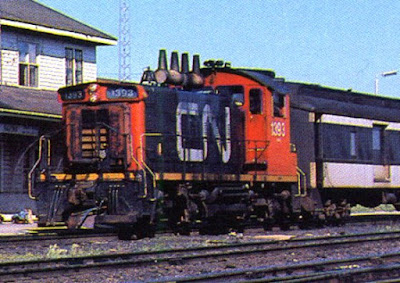Every post card in my collection has its own story. Every Wednesday I post one of the 3,000 plus stories.
Wednesday, June 2, 2021
The Pagwa Cannonball
The very short train pictured on the front of this post card is part of the history of trains that served a very sparsely populated area of northern Ontario. The information below was taken directly from this website: http://www.c-and-e-museum.org/Pinetreeline/other/other29/other29ap.html
In 1912, a bridge was built across the Pagwa River by the National Transcontinental Railway (NTR), then under construction between Moncton, New Brunswick, and Winnipeg, Manitoba. The Pagwachuan River was 1,233.6 miles from Moncton. The railway selected a site 2.3 miles west of the river for Pagwa station. The station site consisted of a large, two-storey station, a section house and a tool shed.
Stations on the National Transcontinental Railway (NTR) were located seven to 10 miles apart. All track maintenance in the early days of the 1900s was done by hand by section crews and short sections were the norm. Every fourth or fifth section also had a water tank for steam locomotive service. The nearest water tank to Pagwa was at Savoff, to the east. The NTR was Canada's third transcontinental railway. It developed out of political controversy and ultimately helped bring about the defeat of the Laurier Liberal government in 1911. The Borden Conservative government replaced the Liberals. The Conservatives opposed building of this railway, but allowed work to proceed to completion. The government did scrap the four-man commission that guided construction of the NTR and replaced it with a one-man commission, RW Leonard. It is significant that the year in which he became the commission, 1912, is also the date that is inscribed in concrete abutments of the Pagwa River bridge.
Canadian Pacific, and later Canadian Northern, were the two transcontinental railways preceding the NTR. But only the NTR ran through Northern Quebec and Northern Ontario, and it was considered a development road. Grand Trunk Pacific Railway was general contractor for the NTR, with funding provided by the federal government. The NTR was to run from Moncton to Winnipeg. The Grand Trunk was to build the remainder of the railway from Winnipeg to the Pacific Ocean. It is significant that it cost $166 million to build the NTR from Moncton to Winnipeg, and only $144 million to build the railway from Winnipeg to Prince Rupert, the Pacific terminus, which included crossing the Rockies. Muskeg in Quebec and Ontario was a bigger challenge than granite.
Construction of the NTR started in 1906 and ended in 1913. But the Grand Trunk Pacific refused to take over the NTR section, scared off no doubt by the high cost of construction. It had to repay the federal government at the rate of three per cent per year of the total construction cost. The NTR languished as a contractor's railway until 1915 when Canadian Government Railways assumed operational control. Scheduled trains began to operate in that year. By 1923, Canadian National Railway Company was formed and it inherited the NTR, the Grand Trunk Pacific and Canadian Northern as well as other small roads.
Regarding the locomotive that is pictured on the post card, the following was taken directly from this website: https://www.american-rails.com/19486.html
The EMD SW1200 began production in January, 1954. The 12-cylinder engine could produce a hefty 1,200 horsepower, which apparently is something many very much liked as EMD's higher-horsepower small switchers tended to sell much better (similar higher horsepower models offered by Baldwin, the American Locomotive Company, and Fairbanks Morse also tended to sell much better). Using General Motors' newer model D37B traction motor the SW1200 could produce a respectable 36,000 pounds of continuous tractive effort (its starting tractive effort was the most offered of any EMD switcher up to that time, 74,000 pounds) and overall weighed just over 122-tons. Sales for the EMD SW1200 quickly took off and with the builder's reputation at the time for being the best manufacturer of diesel locomotives sales remained steady through the 1950s and into the 1960s. Just as with other SW series models, numerous Class Is, shortlines, and private industries purchased the switcher since they could be used in all types of applications from light branch line work to industrial duties. However, what allowed the model to sell so well was its 1,200 horsepower rating, giving many railroads the versatility to use it pulling heavier freight trains. Production on the switcher continued through May, 1966 and when the last unit was outshopped some 1,056 units in total had been produced, which included 287 models built by General Motors Diesel of London, Ontario. It was the most purchased EMD switcher for industries as its power and agility made it ideal in such settings.
Subscribe to:
Post Comments (Atom)



No comments:
Post a Comment
If you know anything about the history of the cards, the trains or the locations, please add them.